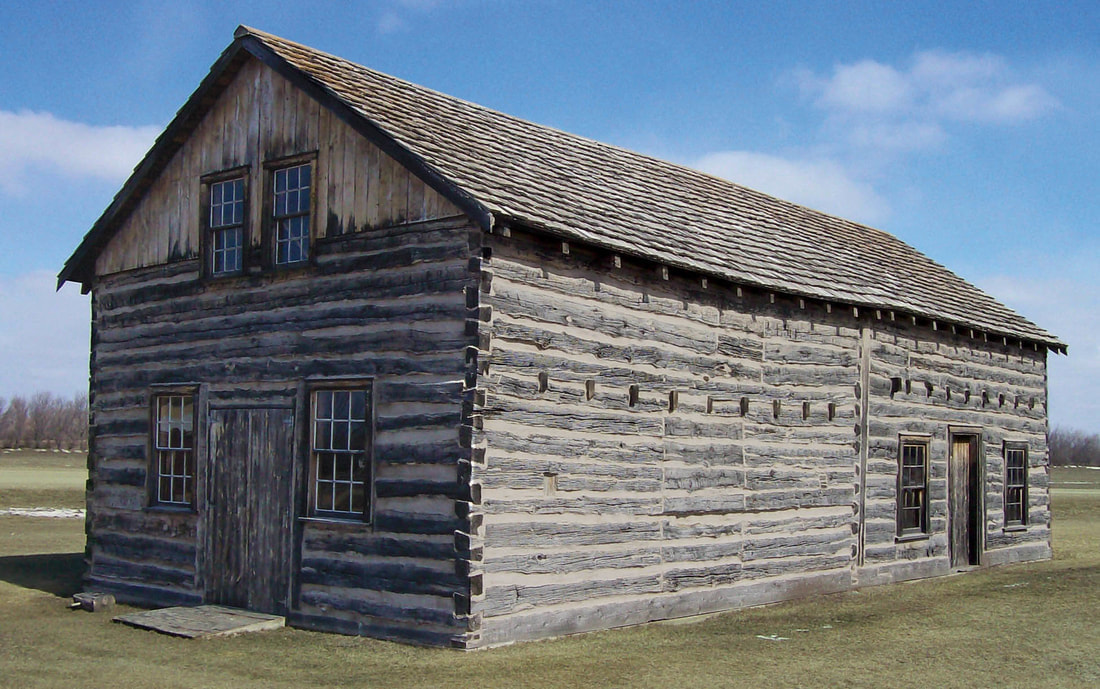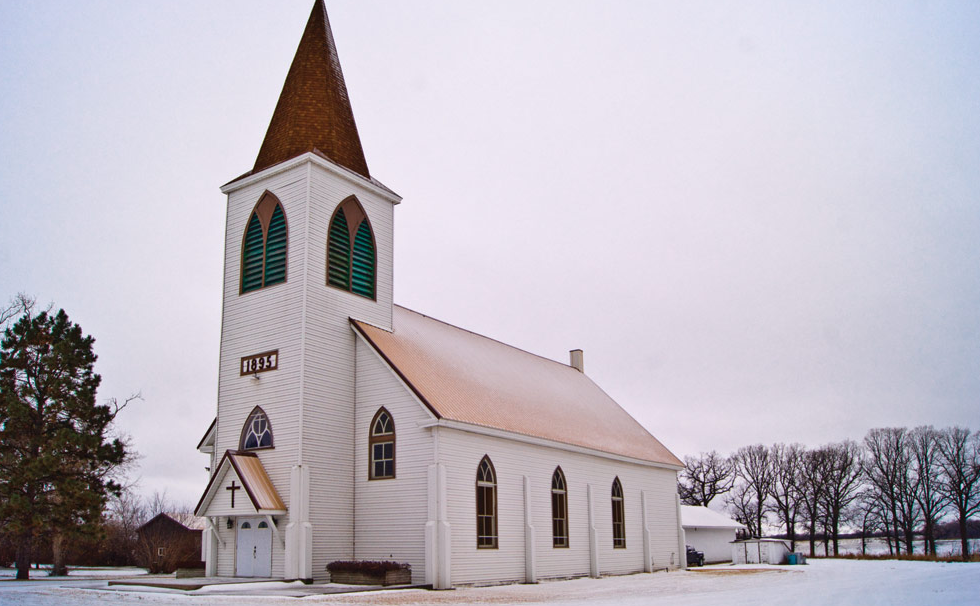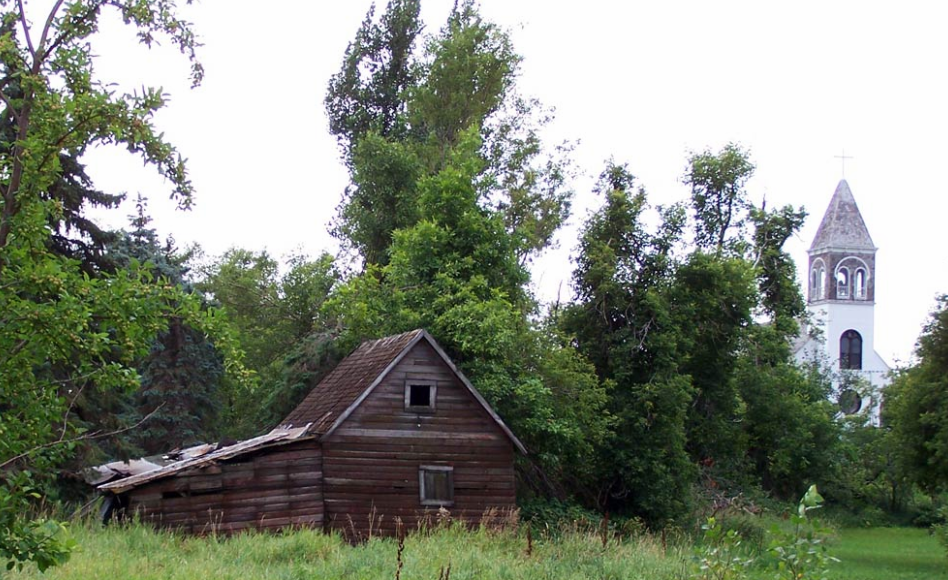|
WALHALLA (ST. JOSEPH) A beautifully situated community located in the wooded river valley at the slope of Second Pembina Mountain, Walhalla (or Old St. Joseph) got its start when trader Norman Kittson built a trading post here in 1843 to take advantage of the many Ojibwe and Metis who camped here throughout the year. Antoine B. Gingras, a half-breed trader, also started a post here in 1843. Later, in 1848, Father George Belcourt established a mission here which was called St. Joseph to work with the 50+ families who made this their regular home. In 1851, additional missionaries arrived, and in 1853 the Pembina Belfry, known as the “Angelus Bell”, was relocated to St. Joseph to officially sanctify the mission. The bell is believed to have been brought from Pembina to St. Joseph by Red River cart. By 1860 the settlement had become an important fur trading post, with a population of 1,800—mostly Metis half-breeds and Plains Ojibwe. In 1862 a post office was established and it was a burgeoning town with a strong community. However, by 1870, the good furs became scarce in the rivers and streams of the Pembina hills, and the buffalo had virtually disappeared. By 1871, Walhalla was inhabited only by a priest, the U. S. customs inspector, and some 50 Metis people who had settled here (more or less) permanently. The town revived and was platted in 1877. It was renamed Walhalla by the Icelandic people who were settling in the region. Although most of the Metis inhabitants left the area, some families still remain in the area until today, and each year a festival is held at the Gingras Trading Post State Park. LEROY Originally known as Leroy’s Trading Post, Leroy was established as a Metis community during the 1850s. This post, on the Pembina River, consisted of several households of Metis log cabins scattered in the timber along the river. In 1873, Father LaFlock transferred the Saint Joseph Mission from Walhalla to Leroy to serve the Metis living here, and a post office was established in 1887. Over the decades, the town lost most of its inhabitants to out-migration and old age. The town is now a ghost town, with no census returns during the 2010 census. However, an interesting legend, or ghost story, does persist for Leroy. A road, known as White Lady Lane, goes through the Tetrault Woods between Leroy and Walahalla. Local legend tells of a young girl who became pregnant out of wedlock. Her religious parents forced her to marry the man against her will, and after the wedding, the baby died. The distraught girl hanged herself from a bridge, and her ghost has been seen hanging from the bridge in her wedding dress. The bridge is located down a narrow road off County 9. OLGA This small town, now nearly a ghost town, Olga was originally known as St. Pierre, due to the mission established by Catholic priest, Cyrille Saint Pierre, who was assigned as postmaster in 1882, but it was shortly thereafter renamed Olga in 1883. A small Metis community lived at this location, and it was a favorite camping ground for the Plains Ojibwe and Metis. During the 1800s, and a famous battle between the Ojibwe/Metis and Dakota Sioux—the Battle of O’Brien’s Coulee—took place about a mile from Olga in 1848. References:
WPA Federal Writers Project (1935). North Dakota: A Guide to the Northern Prairie State. Washington: USGPO Barnes-Williams, Mary Ann (1966). Origins of North Dakota Place Names. Bismarck: Tribune Publishing
13 Comments
Joyce Grant-Worley
12/1/2019 08:14:20 pm
I have a 3gr grandparents (Gingras and Trottier) in Wallhalla. Lots of relation buried at St Boniface church cemetery. Then great grandparent in Leroy (Grant's) and the 2nd greats (Monette's) in Olga. Thanks for the history. The family ended in Belcourt.
Reply
Alison raheem
12/1/2019 08:46:07 pm
Hi. Nice artical, but Olga is not nearly a ghost town. A new house was built. We also have a big celebration on the 4th. That’s all, love our little tiwn
Reply
Leo Beauchamp
12/3/2019 07:21:55 pm
I was born there in 1932 as was my wife and we will always call it home. Our Preservation Society has raised thousands of dollars to restore the church. Our village isn't dead it has just shifted. Many have been returning to celebrate the 4th of July for several years and a big celebration is planned for this year.
Reply
Allan besuchamp
8/24/2022 01:24:45 pm
Hi
Robin Beauclair
12/1/2022 04:59:47 pm
Do you recognize the last name Beauclair or Hebert from around there? Looking for Media records.
Jim Benjaminson
12/3/2019 09:50:03 pm
Walhalla got its name from the U.S. Post Office which changed the name from St. Joseph to Walhalla; they wanted to avoid confusion with the other St. Joseph's in the country.
Reply
HM Johnston
12/17/2019 09:36:30 pm
I grew up in Walhalla, ND. I knew that Walhalla was once called St. Joseph. But, I didn't know, until I saw a Canadian map of the Gorge, that the name was more than that. It was once called St. Joseph a la Mont Ste. Marie. I love it; wish it was still called that.
Reply
8/10/2023 12:19:24 pm
The distraught girl hanged herself from a bridge, and her ghost has been seen hanging from the bridge in her wedding dress. Thank you, amazing post!
Reply
Julie Traeger Julian
11/27/2023 07:28:58 pm
Does anyone know what happened to the original Saint Joseph Roman Catholic Church in Pembina, North Dakota. My great-great-grandfather was John ‘Kootenai’ Brown who married Olivia (a Métis) there on September 26,1869. Is that church still standing? If so, I would like to visit it. - Julie T. Julian, in Richmond Virginia
Reply
7/11/2024 10:10:41 am
Metis History has the most complete History on Ancestors
Reply
Julie T. Julian
7/23/2024 06:24:52 am
Thank you, however I don’t need any further Metis ancestry. It seems the first Saint Joseph’s church was demolished? My question is: does a photo exist of the ORIGINAL Saint Joseph’s church at Pembina? (The church PRIOR to the church currently on that site; before 1895.)
Reply
Marlene Lepine
7/23/2024 07:38:50 am
My grandfather was born in Olga in 1888. Does anyone know if the family of Octave Harvey Lepine, born of Louis Treffle Lepine and Delia Rivard had a metis connection
Reply
Leave a Reply. |
AuthorKade M. Ferris, MSc
Archives
June 2023
Categories |




 RSS Feed
RSS Feed
